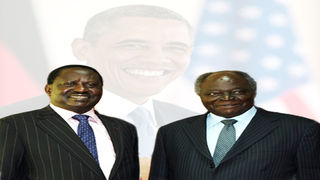
The President Mwai Kibaki and then Prime Minister Raila Odinga. For the first time, Muthaura says, the two of them joined forces to urge the US government to stop the Yes Youth Can programme.
| FilePolitics
Premium
The Sh18bn US war chest that united Kibaki and Raila
What you need to know:
- Francis Muthaura in his memoir – A Moving Horizon – reveals that Mr Kibaki and Mr Odinga who disagreed on nearly everything for the first time presented a united front in pushing the US government to discontinue the program.
A Sh18 billion by former US President Barack Obama’s administration to empower youths to occasion a ‘revolution’ in the country rattled the then President Mwai Kibaki and then Prime Minister Raila Odinga, uncharacteristically uniting them to reject the program.
Former Head of Public Service Francis Muthaura in his memoir – A Moving Horizon – reveals that Mr Kibaki and Mr Odinga who disagreed on nearly everything in the Grand Coalition Government for the first time presented a united front in pushing the US government to discontinue the program.
The empowerment Programme dubbed “Yes Youth Can” by the foreign super power nation was seen as a threat by the political elite over perception that it was designed to overthrow the old guards.
Excerpts of the book that are corroborated by past secret American cables released by wikileaks website reveal how Mr Kibaki and Mr Odinga instructed then Deputy Prime Minister Musalia Mudavadi, the late Internal Security Minister Prof George Saitoti and then Foreign Affairs Minister Moses Wetang’ula to hold a crisis meeting with then US ambassador Michael Ranneberger to demand for discontinuation of the program.
Government functionaries got worried about the programme when the envoy started moving around the country to hold meetings with youths. The youths were told to form groups with a promise of funding running into millions of shillings.
At some point the envoy said the programme was the largest youth programme in the world being implemented through the United States Agency International Development (USAID).
“I remember at this particular time in 2009 when the US Ambassador announced that his government had availed USD 120 million (Sh18 billion based on current exchange rate) to support youth empowerment programmes in the country,” he writes.
“The programme was not received well by the government because its theme was to empower the youth to effect change in the country. Those who participated in the youth workshops and conferences, which took place in many parts of the country, were of the view that the meetings were mobilising the youth to seek to change the government through a revolution,” he recalls.
Mr Muthaura says that both Mr Kibaki and Mr Odinga were concerned by the thrust of the US sponsored youth empowerment programme following mass registration of youth groups across the country.
The principals instructed the ministers – who were drawn from both Mr Kibaki and Mr Odinga side of government to meet the Amb. Ranneberger and “inform him in clear terms that the Kenya government wanted the US youth empowerment programme discontinued as it was undermining the stability of the country.”
He says in the book that the envoy told the ministers that the US was not involved in any sinister agenda through the program. He told them the programme was designed to support the development of the youth.
“The ministers insisted that the government considered the programme disruptive and was, therefore, formally requesting its discontinuation. The US government silently discontinued the programme,” writes Mr Muthaura.
But secret American cables that became public in 2011 quoted the US Embassy in Kenya saying it would push on with the program.
A secret letter from Mr Ranneberger to Secretary of State Hilary Clinton said the embassy is solidly behind youth groups, whose “ultimate objective is the emergence of alternative political leadership”.
The youth groups were supposed to end tribal politics, help in reconciling the various tribes and implementation of reforms.
The cables said that senior levels of the Coalition government had “sought to pressure us to curtail such activity. We pushed back firmly.” One of the cables named President Kibaki as the person who was opposed to America’s involvement with the youth.
Others named were Mr Mudavadi, Prof Saitoti, Mr Wetang’ula and Mr Muthaura. According to the cables, on November 2, 2009, Amb. Ranneberger drove to the State House to deliver a letter from President Obama.
Shortly after he delivered the message, President Kibaki pointed out – “rather vaguely” – that there were concerns about the US support for youth groups.
But “before a discussion could take place”, the envoy says in a secret cable to Secretary of State Hillary Clinton, “the President’s permanent secretary (Francis) Muthaura jumped in to say the President had another meeting, and the President left the room.
“Muthaura then told me that some of the government Ministers wanted to talk with me.”
Waiting for Mr Ranneberger were Mr Mudavadi, Prof Saitoti and Mr Wetang’ula. Mr Odinga is alleged in the cables to have later told Mr Ranneberger that Mudavadi was “pressured” to attend the meeting.
The group is said to have expressed concern about the funding of youth activities and told Mr Ranneberger that such activities were “unhelpful”.
Mr Ranneberger, the cables indicate, told them that he “did not appreciate the veiled threat. He later narrated to Mrs Clinton how he “pushed back hard, acknowledging US support for the meeting, but making clear that the agenda and participation were being organised by the youth organisations”.
A week before the forum, on November 10, Mr Ranneberger said he received a call from Mr Wetang’ula, who said “the government still did not want the forum to take place.”





